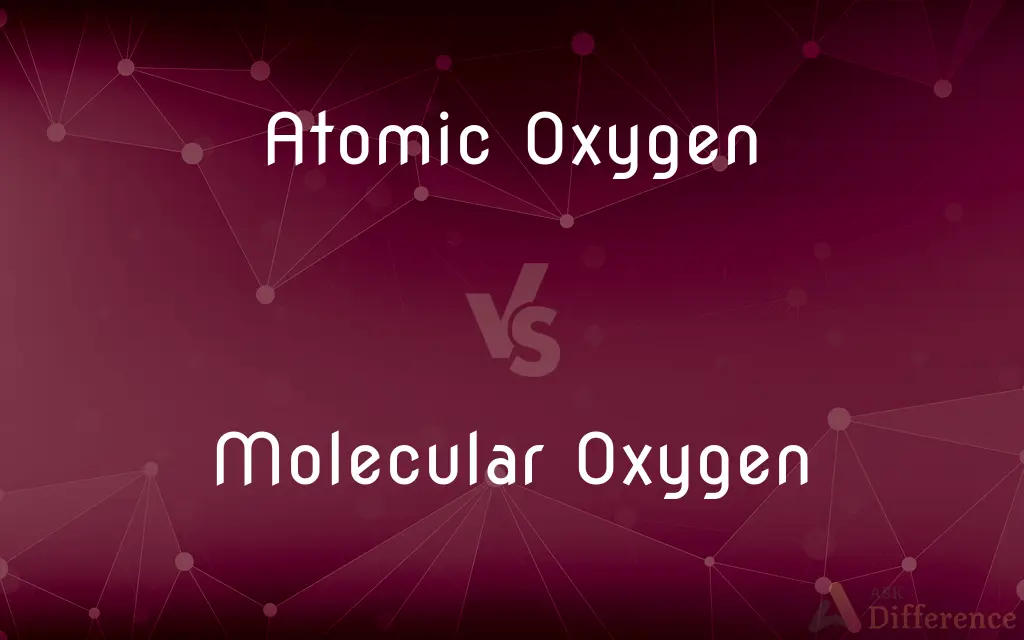Atomic Oxygen vs. Molecular Oxygen — What's the Difference?
By Fiza Rafique & Urooj Arif — Published on March 3, 2024
Atomic oxygen refers to individual oxygen atoms, highly reactive and rare on Earth's surface, while molecular oxygen (O2) is a stable diatomic molecule, essential for respiration and common in Earth's atmosphere.

Difference Between Atomic Oxygen and Molecular Oxygen
Table of Contents
ADVERTISEMENT
Key Differences
Atomic oxygen consists of single oxygen atoms, which are notably reactive and short-lived under normal conditions on Earth. This reactivity makes atomic oxygen a key player in chemical reactions in the upper atmosphere but less common near the surface.
Molecular oxygen, or O2, is composed of two oxygen atoms bonded together. It is the form of oxygen most familiar to us, being crucial for the process of respiration in living organisms and supporting combustion.
The high reactivity of atomic oxygen leads to its significant role in the upper atmosphere, where it interacts with solar radiation and other atmospheric components. These interactions are vital for phenomena such as the aurora and the formation of ozone (O3).
The molecular oxygen's stability makes it a cornerstone of life on Earth, enabling efficient energy production within cells through cellular respiration. Its abundance in the Earth's atmosphere is a direct result of photosynthesis by plants and certain bacteria.
Atomic oxygen is primarily found in the Earth's upper atmosphere, especially in the thermosphere, where it is generated by the dissociation of molecular oxygen by ultraviolet (UV) light from the Sun. This environment contrasts with the lower atmosphere, where molecular oxygen prevails.
ADVERTISEMENT
Comparison Chart
Symbol/Formula
O
O2
Reactivity
Highly reactive
Relatively stable
Presence on Earth
Rare, mainly upper atmosphere
Abundant, throughout the atmosphere
Role in Atmosphere
Interacts with solar radiation, forms ozone
Essential for respiration, supports combustion
Formation
By dissociation of O2 by UV light in the upper atmosphere
Primarily through photosynthesis and water splitting
Compare with Definitions
Atomic Oxygen
Known for its role in atmospheric chemistry.
Atomic oxygen damages spacecraft materials in low Earth orbit.
Molecular Oxygen
Produced by photosynthesis in plants.
Plants release molecular oxygen as a byproduct of photosynthesis.
Atomic Oxygen
Generated by the dissociation of molecular oxygen by UV light.
Atomic oxygen is produced when ultraviolet rays split O2 molecules.
Molecular Oxygen
Predominant form of oxygen in Earth's atmosphere.
Molecular oxygen makes up about 21% of the Earth's atmosphere.
Atomic Oxygen
Atomic oxygen refers to single oxygen atoms with high reactivity.
Atomic oxygen in the upper atmosphere is crucial for forming the ozone layer.
Molecular Oxygen
Necessary for aerobic respiration in organisms.
Cellular processes in animals utilize molecular oxygen to generate energy.
Atomic Oxygen
Rare on Earth's surface due to its reactivity.
Atomic oxygen quickly reacts to form O2 or O3 when present near the surface.
Molecular Oxygen
Supports combustion and is vital for fires.
Molecular oxygen is a key component that fuels fire.
Atomic Oxygen
Involved in the formation of ozone.
Atomic oxygen reacts with O2, facilitated by UV light, to create ozone.
Molecular Oxygen
Molecular oxygen is a diatomic molecule, essential for life.
Humans breathe molecular oxygen for cellular respiration.
Common Curiosities
Why is molecular oxygen important for life?
It is crucial for the process of cellular respiration, allowing organisms to produce energy from food.
How is atomic oxygen formed?
It is formed by the dissociation of molecular oxygen by ultraviolet light from the Sun in the upper atmosphere.
Can atomic oxygen exist on Earth's surface?
It exists momentarily due to its high reactivity, quickly reacting to form molecular oxygen or ozone.
How do plants contribute to the presence of molecular oxygen?
Plants release molecular oxygen into the atmosphere as a byproduct of photosynthesis.
What is molecular oxygen?
Molecular oxygen (O2) is a stable molecule composed of two oxygen atoms, essential for respiration and common in the Earth's atmosphere.
Why is atomic oxygen considered highly reactive?
Due to its unpaired electron, it readily reacts with other substances to form more stable compounds.
Is molecular oxygen reactive?
While less reactive than atomic oxygen, it supports combustion and is reactive under certain conditions.
What is atomic oxygen?
Atomic oxygen consists of single oxygen atoms, highly reactive and primarily found in the Earth's upper atmosphere.
How does ultraviolet light affect molecular oxygen?
Ultraviolet light can split molecular oxygen into two atomic oxygens, particularly in the upper atmosphere.
Where is atomic oxygen most commonly found?
It is most commonly found in the Earth's upper atmosphere, especially in the thermosphere.
How does the presence of molecular oxygen affect fires?
It is a key component that supports and sustains combustion, making it vital for fires to burn.
What happens when atomic oxygen interacts with spacecraft materials?
It can cause significant damage through oxidation, affecting the longevity and safety of spacecraft.
What role does atomic oxygen play in the atmosphere?
It plays a key role in atmospheric chemistry, including the formation of ozone and interaction with solar radiation.
What distinguishes atomic oxygen from molecular oxygen in terms of chemical formula?
Atomic oxygen is represented as O, while molecular oxygen is represented as O2.
What is the significance of ozone formation involving atomic oxygen?
Ozone formation, involving atomic oxygen, protects life on Earth by absorbing harmful ultraviolet radiation from the Sun.
Share Your Discovery

Previous Comparison
Sociology vs. Social Science
Next Comparison
Trains vs. TramsAuthor Spotlight
Written by
Fiza RafiqueFiza Rafique is a skilled content writer at AskDifference.com, where she meticulously refines and enhances written pieces. Drawing from her vast editorial expertise, Fiza ensures clarity, accuracy, and precision in every article. Passionate about language, she continually seeks to elevate the quality of content for readers worldwide.
Co-written by
Urooj ArifUrooj is a skilled content writer at Ask Difference, known for her exceptional ability to simplify complex topics into engaging and informative content. With a passion for research and a flair for clear, concise writing, she consistently delivers articles that resonate with our diverse audience.
















































